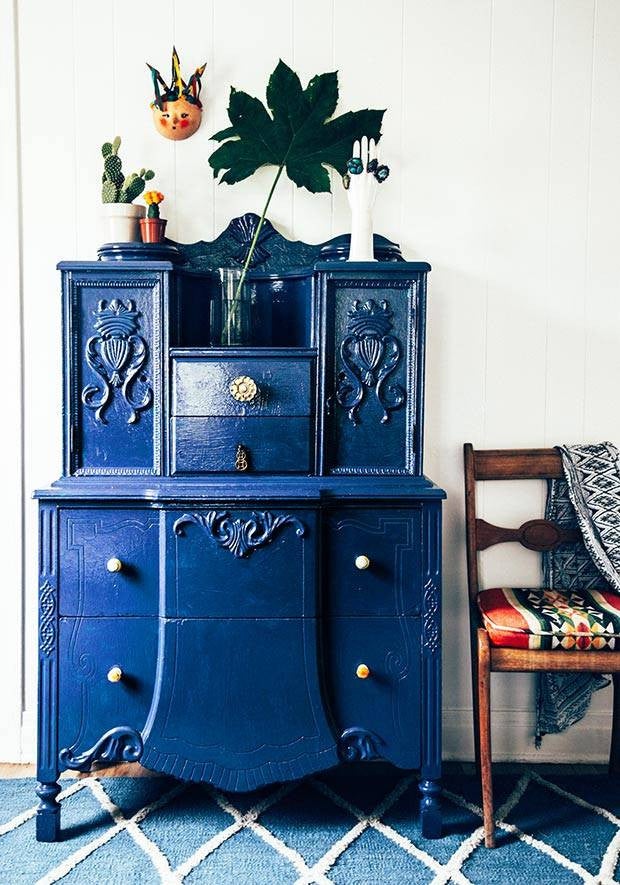8 questions to ask an expert before you paint your furniture
Published Apr 20, 2016 5:00 AM
We may earn revenue from the products available on this page and participate in affiliate programs.
text by ALYSSA CLOUGH
Vintage painted chests, dressers, and cabinets are Pinterest eye candy. Whether they’re painted a pretty pastel or striking, bolder hue, you’ve seen them, and probably wondered to yourself if you could ever pull off a piece like that in your home. But where to even begin? Much like refinishing your first piece of furniture, the logistics can feel dizzying. Cue giving up before the DIY project even has a chance to start. Newsflash: The cycle can be broken! Take advantage of the warm, spring weather and this expert advice from Azie Shelhorse, designer and owner at {verdigreen}, and paint yourself a pretty piece of statement furniture–the right way.
ARE THERE ANY DEAL BREAKERS WHEN IT COMES TO BUYING FURNITURE THAT YOU KNOW YOU’RE GOING TO PAINT?
If I am purchasing furniture to paint, I look for something structurally sound with a good shape that needs updating. If I find an item of value in excellent vintage condition with a beautiful wood grain, I opt to restore it with wood finishing oil instead. I am by no means a wood purist but I don’t paint everything, either.
IS SANDING NECESSARY BEFOREHAND? HOW THOROUGH DO YOU NEED TO BE? WHAT IF YOU’RE LOOKING TO SIMPLY PAINT A DESIGN OVER THE WOOD, NOT COVER IT COMPLETELY?
To sand or not to sand? It depends on the type of paint you choose. I use Chalk Paint® by Annie Sloan which requires no sanding or priming, however if you are using spray paint or house paint you may need to lightly scuff the surface with sand paper to give the piece some “tooth”. If you are looking to paint a design over the wood, just check your paint instructions to ensure it will bond to a previously applied finish, varnish, or veneer.
ARE THERE CERTAIN TYPES OF WOOD FINISHES THAT MAKE PAINTING A NO-GO? OR WOOD FINISHES THAT ARE BETTER FOR PAINTING?
Depression Era furniture is notorious for bleed-through so if you find a curvy 1930s vanity, be sure to do a test swatch before coating it in
white paintYou may need to seal the piece prior to painting in this case. Vintage furniture paints beautifully because in most cases the wood has dried a bit over time and it accepts the paint similarly to raw wood. Speaking of raw, IKEA’s line of raw pine and bamboo furnishings are also fun to redesign with a little paint and creativity.
WILL YOU BE ABLE TO SEE CHIPS AND DENTS AFTER PAINTING?
It depends on the viscosity of your paint, as some thicker paints fill in small imperfections, however even if the chips and dents are still there, they won’t be as notable once the piece is painted as it will look fresh and cohesive. Some like the character chips and dents give a piece so they will use a dark wax or glaze to rest in the low relief to enhance the look after painting.
ARE THERE ANY PAINTING TECHNIQUES YOU WOULD RECOMMEND? WHEN PAINTING ANYTHING, THE THICKNESS AND EVENNESS OF THE PAINT (AND DON’T FORGET BUBBLING!) IS ALWAYS A CONCERN.
Painting technique varies depending on the look you are going for. For a Modern look you can dip your brush in water every so often (if using a water-based paint) to level out brush strokes, lightly sand once dry with a high grit (400) then finish your piece with a buffed wax for high shine. If you love the Euro or Industrial look, use a cross-hatch technique to build texture and use a matte, saturated paint. Good quality paint on a clean surface will not bubble. That typically happens when there is moisture trapped underneath the finish and latex is used.
DO YOU HAVE TO USE A SPECIFIC TYPE OF PAINT? OR DOES ANYTHING WORK?
There are so many options for today’s DIY enthusiast—we are so fortunate that paint has come a long way from mixing pigments with lead! My recommendation would be to find a non-VOC option and to stay away from glossy latex which can look plastic-y once painted. I’ve used Chalk Paint® by Annie Sloan for years because I love that it’s non-toxic, requires little to no prep, and provides a quick and beautiful finish. It’s also incredibly versatile—I have painted a sofa with it, used it to dye fabrics, and painted walls.
DO YOU RECOMMEND LAYERING OR MIXING COLORS?
Mixing and layering can be so much fun! If you are painting to express yourself and practice creative license then go for it! I love a piece that looks like it has been painted again and again over time. Remember if you are mixing to jot down your recipe or pre-mix a large enough batch to avoid running out of your custom color.
ARE THERE ANY FINISHES OR GLOSSES YOU WOULD RECOMMEND?
The finish you choose depends on the paint you use. Some paints are a color and sealer in one and require no further finish. I personally love a hand-rubbed wax finish because it’s not only durable but silky smooth and easy to repair if needed. Be sure to read the instructions on your finish because most require a cure time prior to heavy use. Remember to treat your new painted piece with loving care—sit back and enjoy your work of heart!
